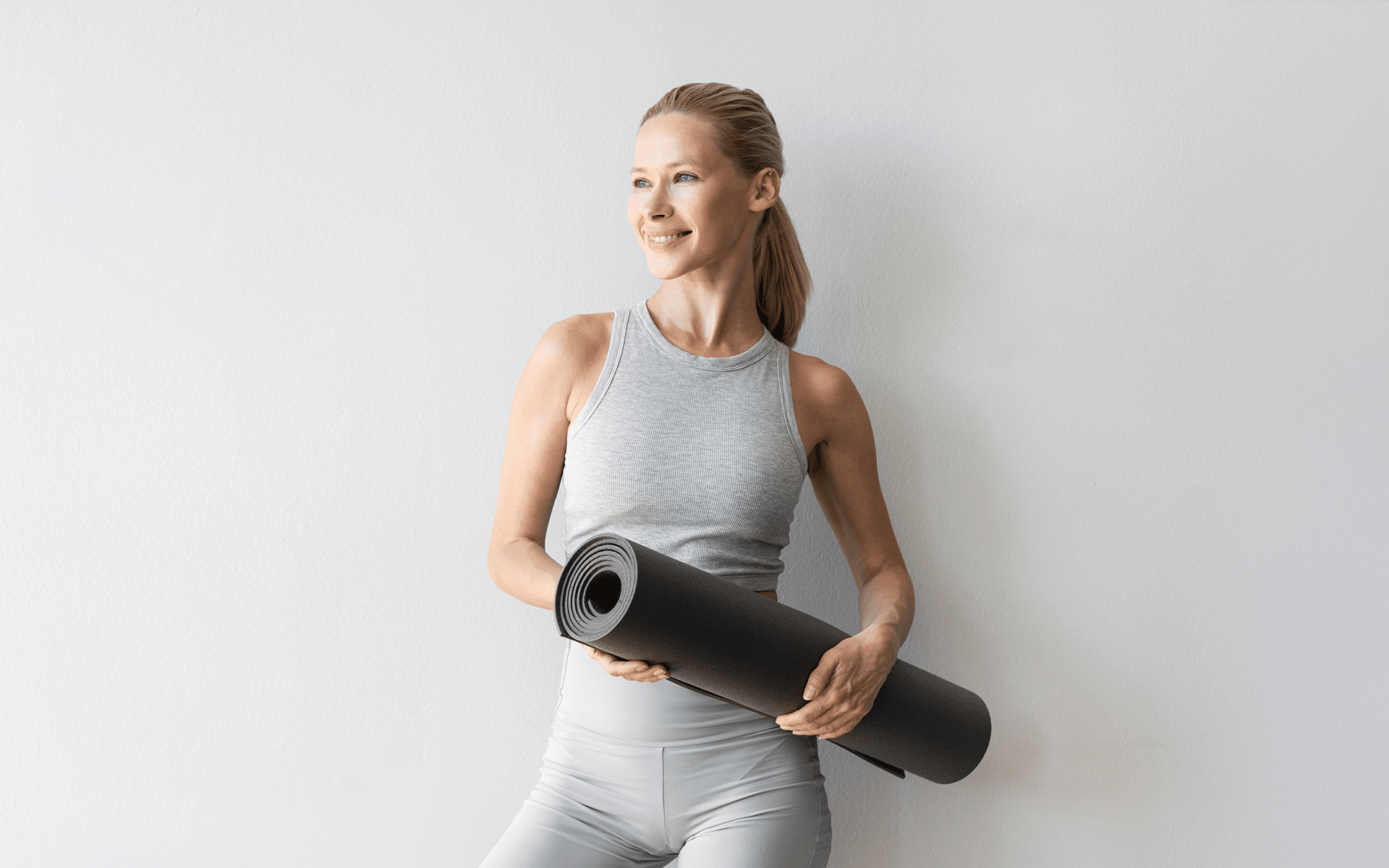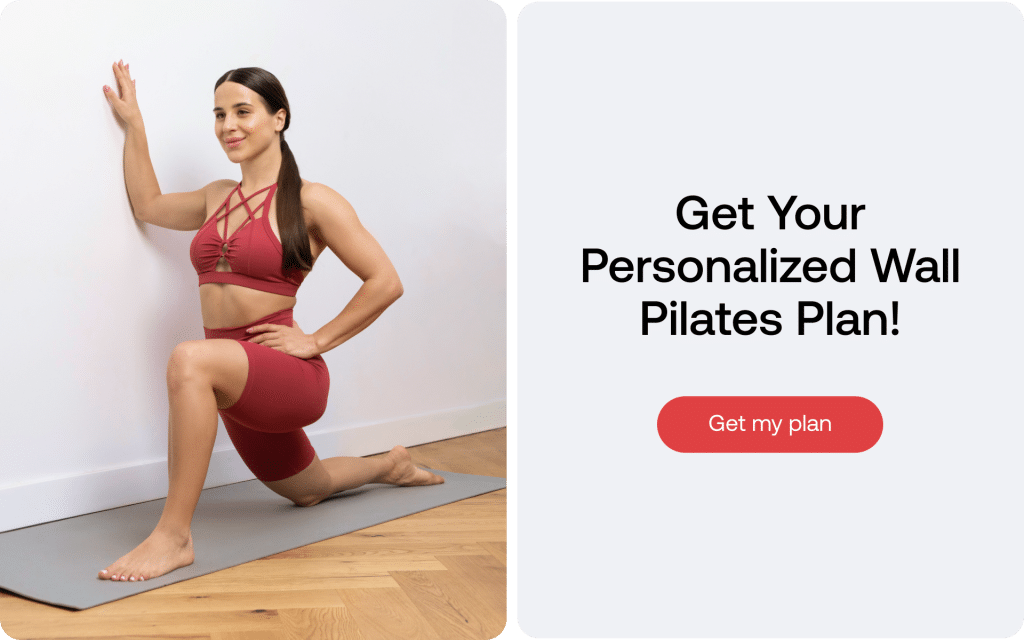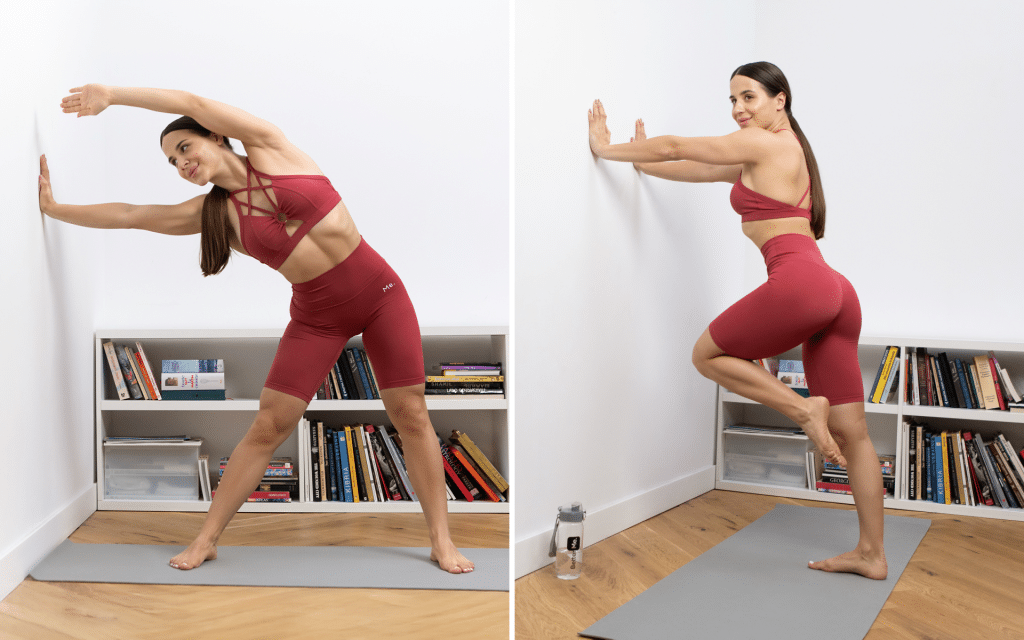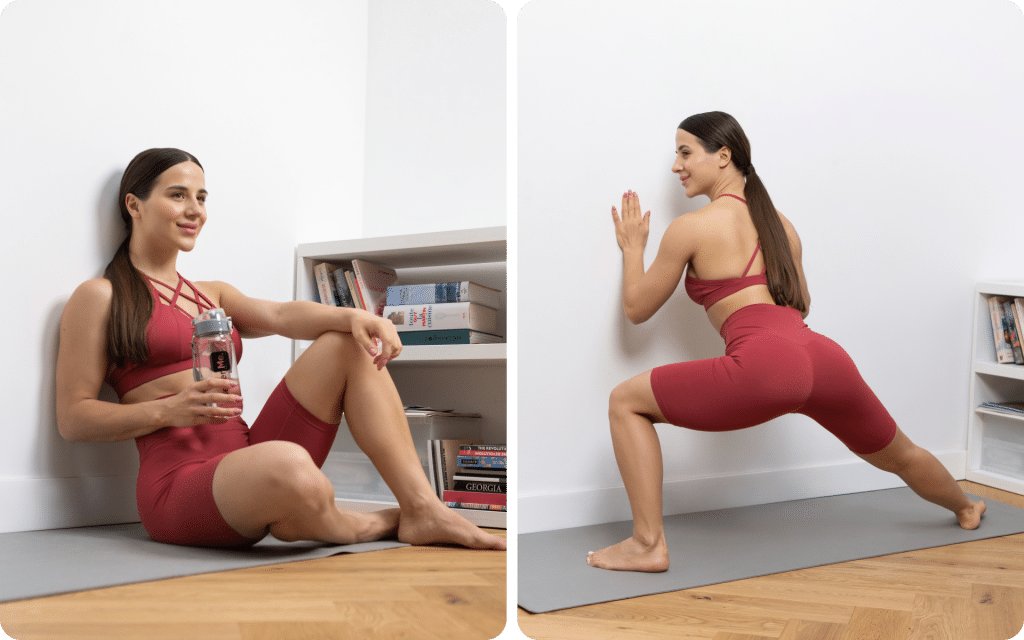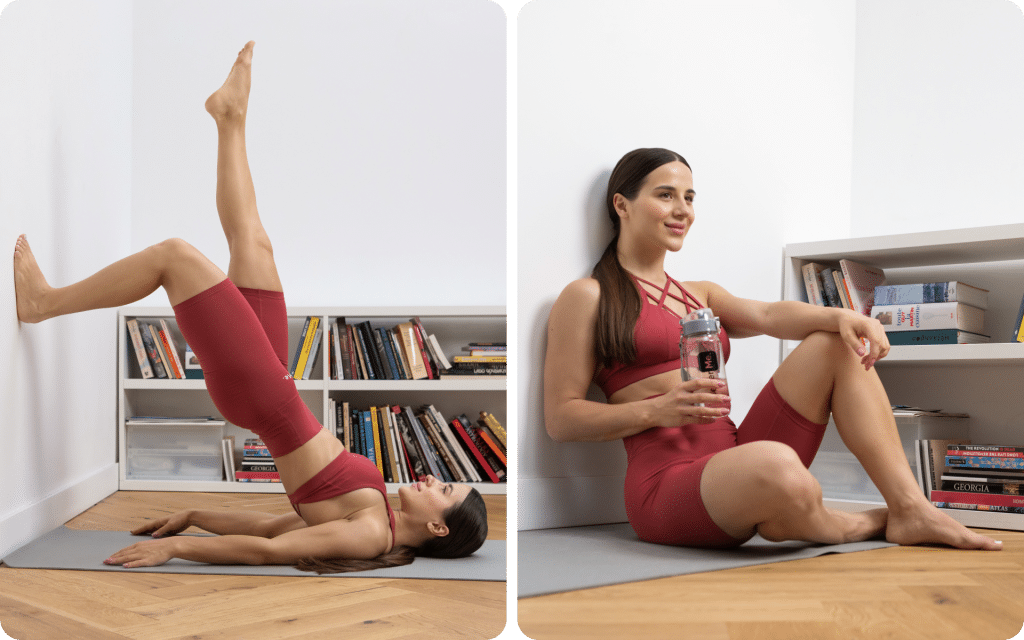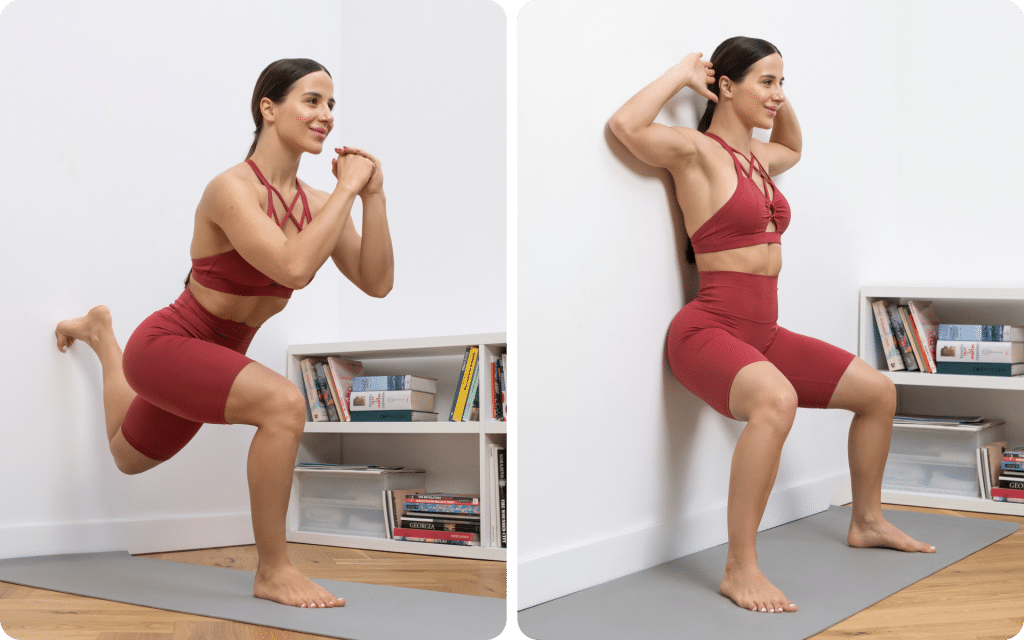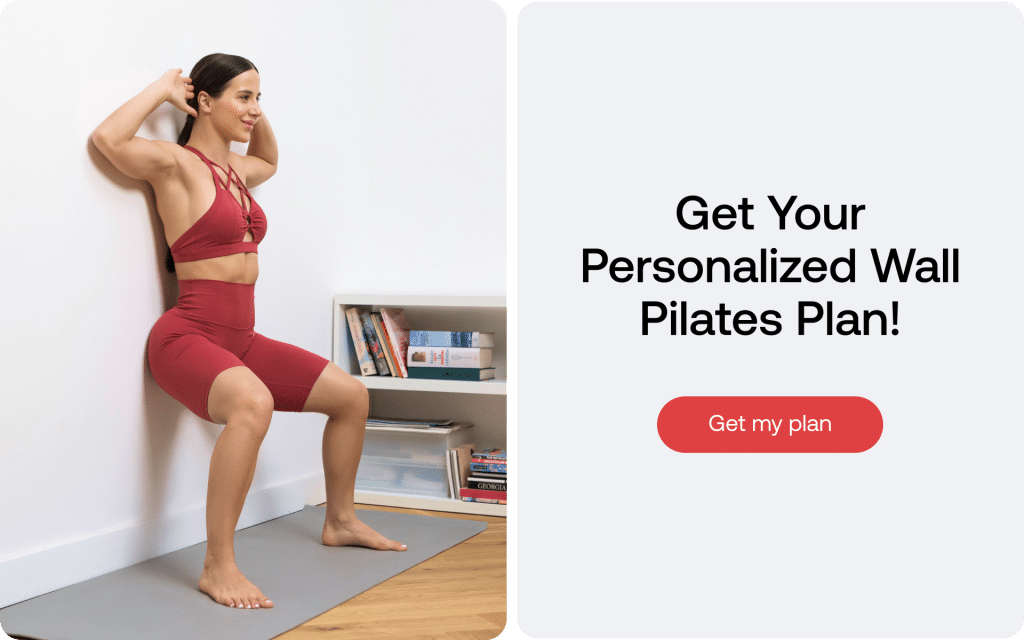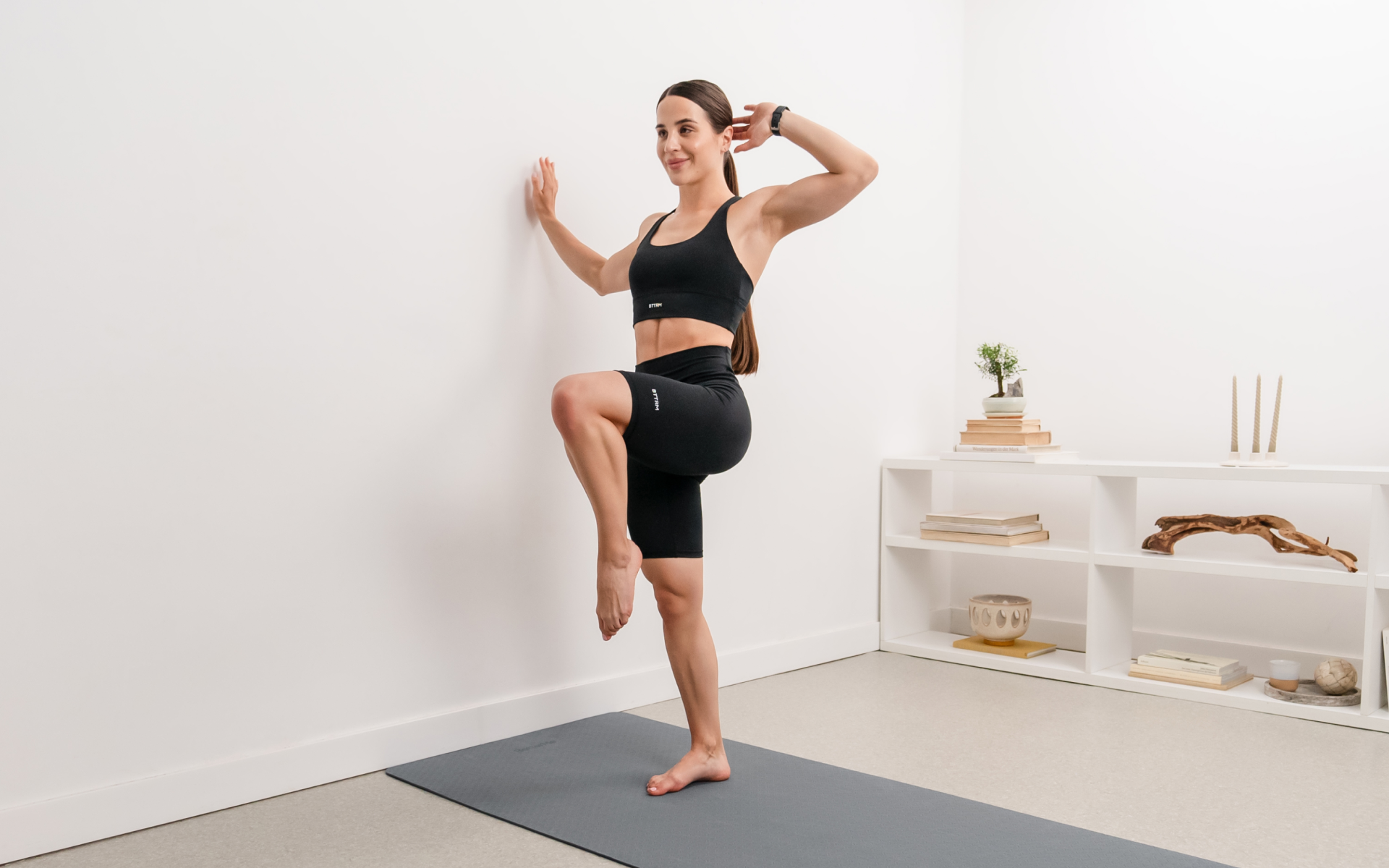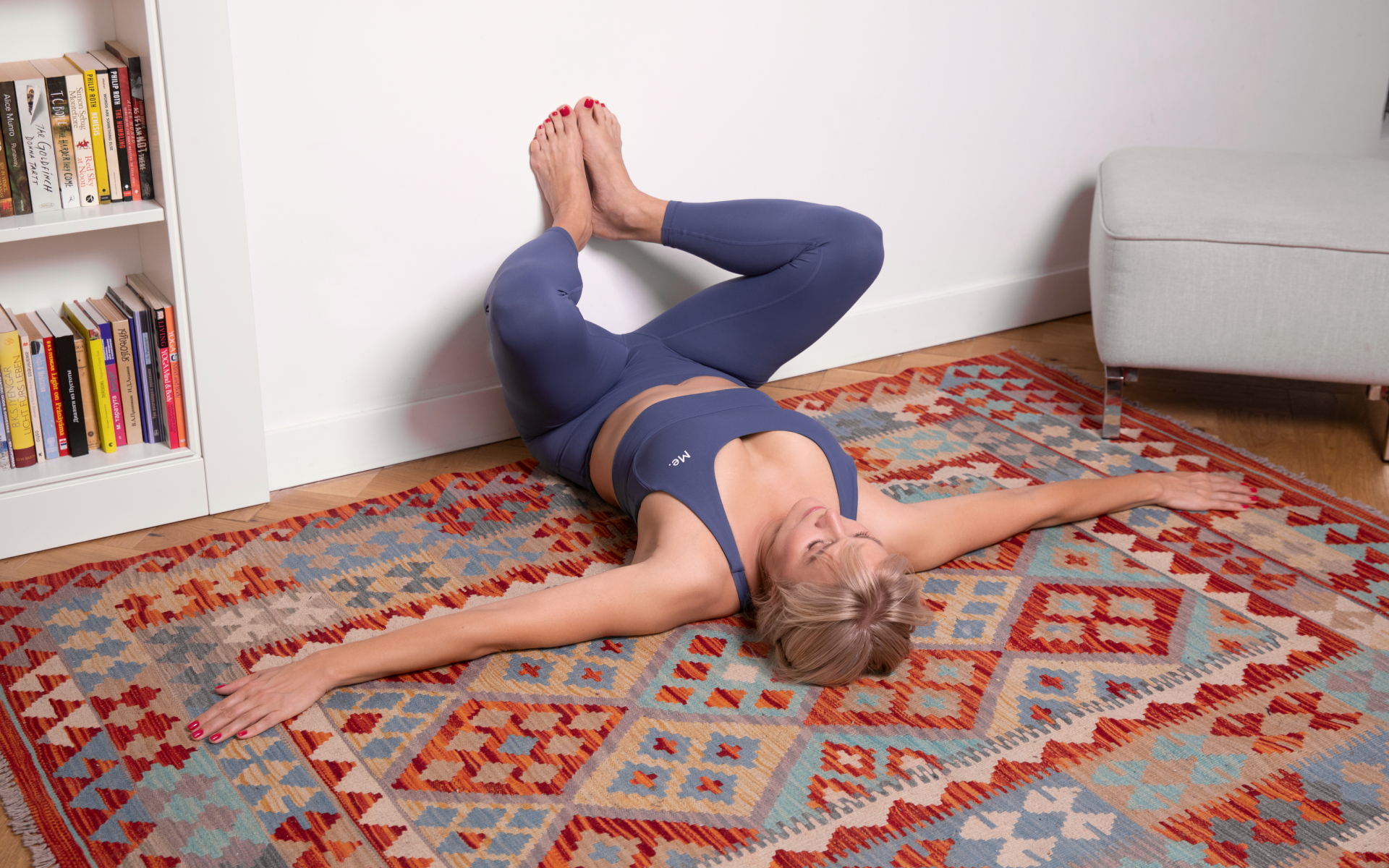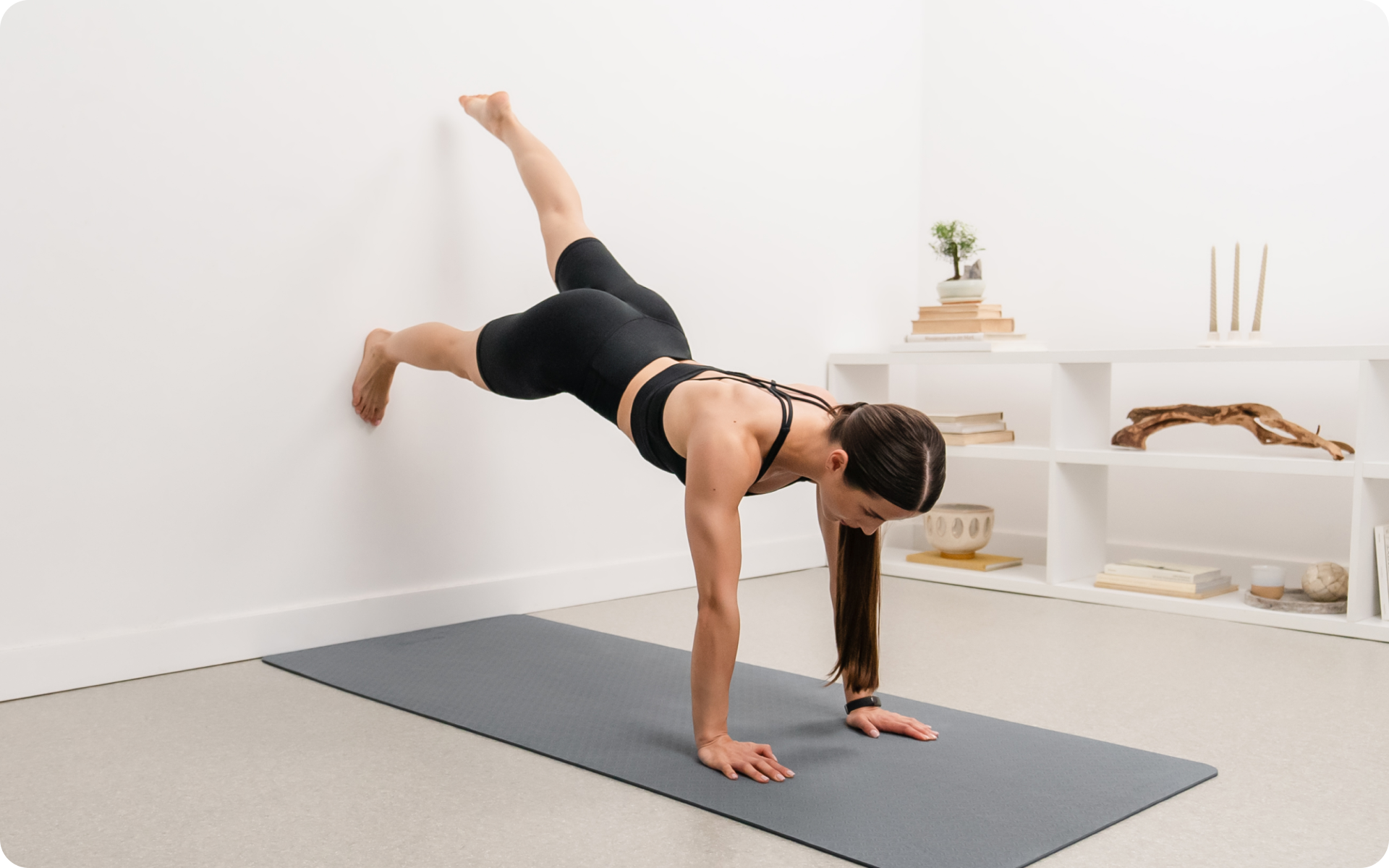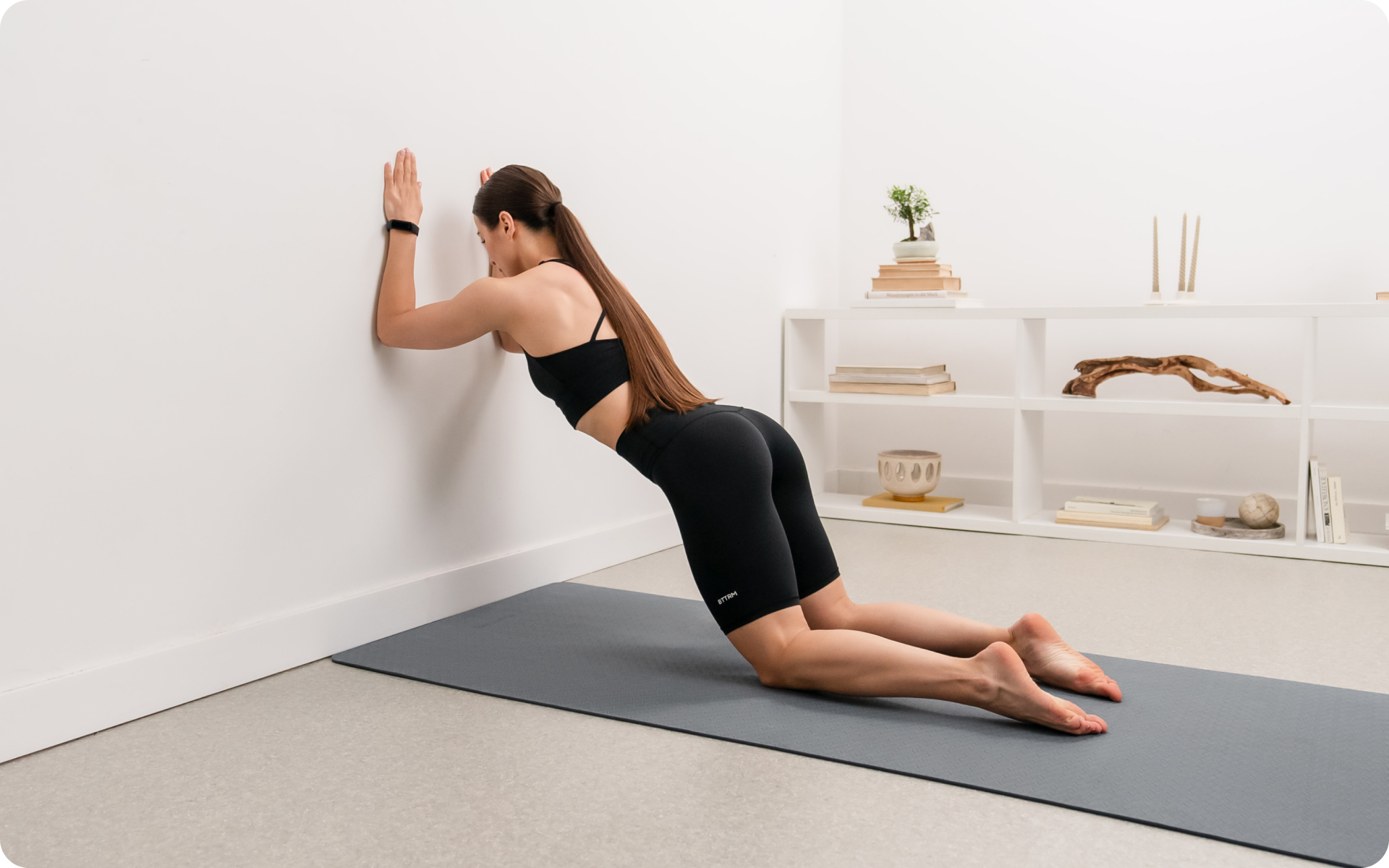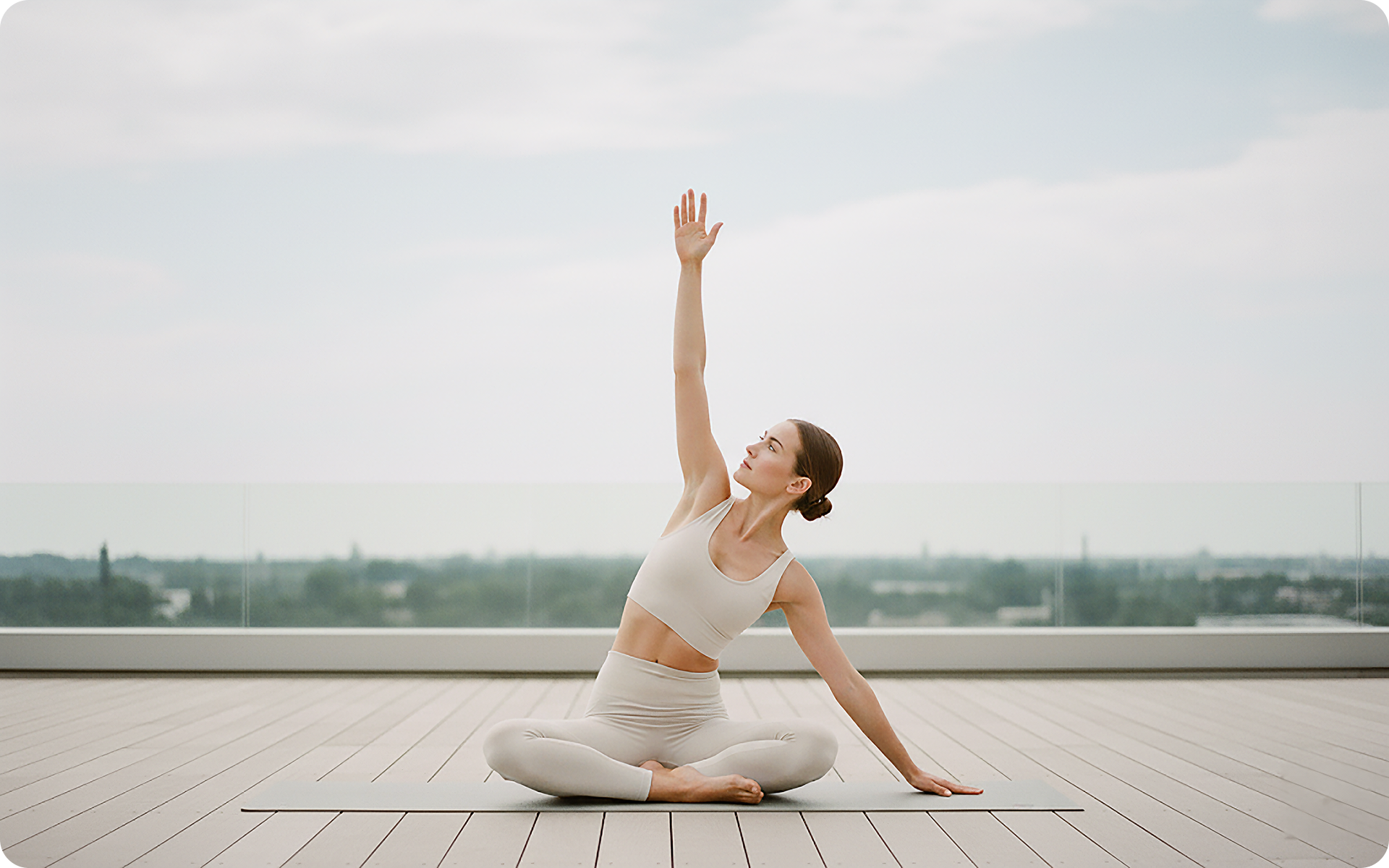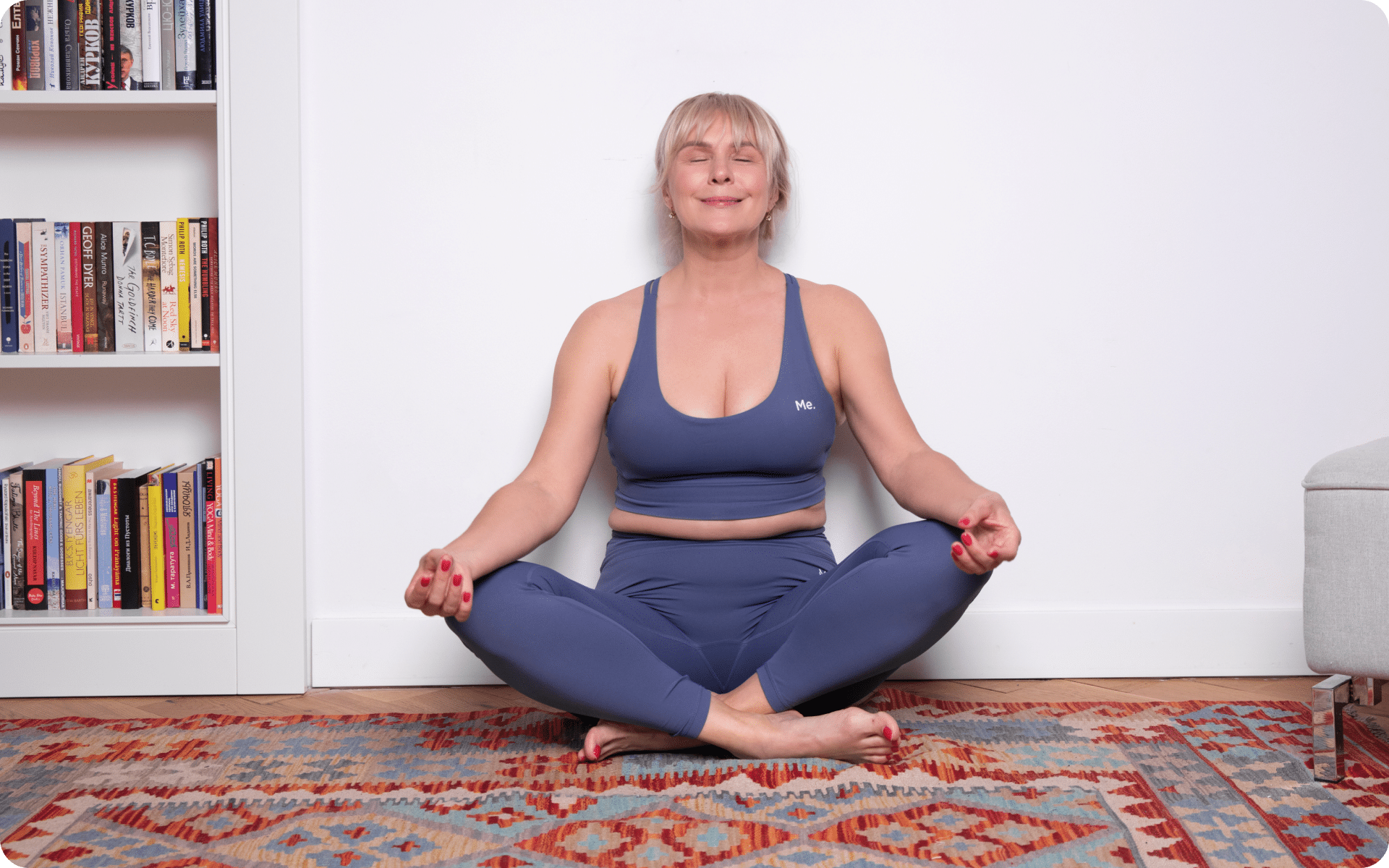Joseph Pilates created his famous exercise system many years ago.
Since then, it has evolved and adapted into various forms to suit different needs and preferences. One such form is Wall Pilates, which uses a wall as a prop for added support and stability during exercises.
Contrary to popular belief, Wall Pilates is not just for beginners or those with injuries.
When incorporated into a regular Pilates practice, it can also challenge the body in new ways and provide additional benefits.
What Are Some Examples Of Wall Pilates Exercises?
Here are 3 examples of Wall Pilates exercises for beginners and experienced Pilates practitioners, with unique benefits listed for each exercise.
1. Wall Roll-Down
The wall roll-down exercise is a great way to warm up the spine and increase flexibility in the back muscles.
To do this exercise:
- Stand facing the wall with your feet hip-width apart and your hands resting on the wall at chest level.
- Inhale as you lengthen your spine and engage your abdominal muscles.
- Exhale as you slowly lower your chin towards your chest and roll your spine down towards the floor, keeping your hands on the wall.
- Once you reach a comfortable stretch, hold for a few breaths before slowly rolling back to standing.
Some benefits of this exercise include:
- Activation of core muscles
- Improved spinal flexibility and mobility
- Increased body awareness and control through slow movement
BetterMe: Health Coaching app helps you achieve your body goals with ease and efficiency by helping to choose proper meal plans and effective workouts. Start using our app and you will see good results in a short time.
2. Wall Squats/Sits
Wall squats are a great way to challenge the lower body.
To do this exercise:
- Stand with your back against the wall, feet hip-width apart, and legs straight.
- Slowly slide down the wall into a squat position, keeping your knees in line with your ankles.
- Hold the squat position for a few breaths before pushing through your heels to stand back up.
Some benefits of this exercise include:
- Improved balance and stability through controlled movement
- Activation of core muscles for added support during the squat
- Strengthening of the quadriceps, hamstrings, and glute muscles
3. Wall Push-Ups
Wall push-ups are a modified version of traditional push-ups that can still provide an effective upper-body workout.
To do this exercise:
- Stand facing the wall with your arms extended and hands resting on the wall at shoulder level.
- Inhale as you bend your elbows and slowly lower your chest towards the wall.
- Exhale as you push back up to the starting position.
Some benefits of this exercise include:
- Strengthening of the chest, shoulder, and arm muscles
- Improved upper body strength without putting too much strain on the wrists or shoulders
- Activation of core muscles for stability during the movement
Read more: Home Pilates Workout Guide: Strengthen Your Core
Do Pilates Wall Workouts Really Work?
While specific research on wall Pilates is limited, the principles of isometric training (which wall Pilates utilizes) are well-documented for their effectiveness in building strength while placing minimal stress on the joints.
Anecdotal evidence from practitioners suggests improvements in flexibility, strength, and core stability.
- Stability And Support
The wall provides stability, making it easier for beginners to maintain proper form and alignment. This support is particularly beneficial for those who might struggle with balance or are new to Pilates.
- Resistance And Strength Building
By using the wall, exercises can mimic the resistance provided by Pilates reformer machines. Resistance can enhance strength-building, particularly in the core, legs, and glutes (1).
- Accessibility And Convenience
Wall Pilates can be done at home without expensive equipment, making it an accessible option for many.
It requires only a wall and a mat, making it a cost-effective workout solution that simplifies how to do Pilates at home. As long as you have a wall and a mat, you can use the exercise routine below for examples of wall pilates exercises at home.
- Mind-Body Connection
Like traditional Pilates, wall workouts emphasize the mind-body connection, helping practitioners develop better body awareness and control. This connection can lead to improved posture and reduced risk of injury (2).
What’s An Effective Daily Routine Sample For Wall Pilates?
This routine includes a warm-up, main exercises, and a cool-down to create a mindful and well-balanced practice.
Warm-Up:
- Wall Roll Down
Purpose: Warm up the spine, engage the core, and improve spinal flexibility.
- Stand with your back against the wall, feet hip-width apart, about 6 inches from the wall.
- Relax your shoulders and rest your arms by your sides.
- Take a deep inhale, then exhale as you slowly roll down one vertebra at a time, tucking your chin to your chest.
- Pause at the bottom for one breath, then inhale and slowly roll back up.
- Repeat 5-6 times, focusing on a smooth and controlled rhythm.
- Wall Cat Stretch
Purpose: Stretch and mobilize the spine, warming your core and back muscles.
- Stand facing the wall with your hands pressed against it at shoulder height, arms straight.
- Step back slightly so your body forms an angle with the wall.
- Exhale and round your back as if making a “C” shape, tucking your pelvis and chin.
- Inhale as you arch your spine slightly, lifting your gaze while keeping your shoulders relaxed.
- Alternate between these two positions for 6-8 rounds, focusing on a fluid motion.
- Wall Side Bend
Purpose: Warm up the obliques and increase flexibility in the sides of your body.
- Stand sideways to the wall, about an arm’s length away, with your feet hip-width apart.
- Place your closer hand on the wall for support, and reach your opposite arm overhead.
- Exhale and gently bend your torso toward the wall, feeling a stretch along your side.
- Return to the center and repeat 6-8 times before switching sides.
Main Routine:
- Wall Plank With Leg Lift
Purpose: Strengthen the core, shoulders, and legs while improving stability.
- Face the wall and place your hands flat against it at shoulder height. Step back until your body forms a diagonal line.
- Engage your core and ensure your back stays flat.
- Slowly lift your right leg behind you, keeping it straight and controlled, without arching your lower back.
- Lower the leg and repeat on the left side.
- Perform 8-10 leg lifts per side.
- Wall Bridge With Marches
Purpose: Strengthen the glutes, hamstrings, and core muscles.
- Lie on your back, feet flat against the wall, knees bent to 90 degrees. Keep your arms by your sides, palms down.
- Engage your core, then exhale as you lift your hips toward the ceiling into a bridge position.
- Once stable, lift your right foot off the wall into a “marching” motion, keeping your hips steady.
- Place the foot back on the wall, then repeat with the left leg.
- Alternate sides for 6-8 marches on each leg while maintaining control.
- Wall Side-Lying Leg Lifts
Purpose: Target the outer thighs, glutes, and core for improved stability and balance.
- Lie on your right side on a mat, with your back pressed lightly against the wall.
- Straighten your legs so they form a long line against the wall.
- Keep your core engaged as you lift your top leg, sliding it slightly up the wall.
- Lower the leg with control, ensuring your hips don’t tilt forward or back.
- Repeat 10-12 steady lifts, then switch to the other side.
- Wall Push-Up With Arm Reach
Purpose: Strengthen the arms, shoulders, chest, and core while improving balance.
- Stand facing the wall, feet hip-width apart, and place your hands on the wall at shoulder height.
- Step back slightly until your body forms a straight line.
- Perform a controlled wall push-up, lowering yourself toward the wall by bending your elbows.
- When you straighten back up, lift one arm off the wall and extend it to the side.
- Return to the starting position and repeat with the other arm.
- Complete 6-8 push-ups per side.
Cool-Down:
- Single-Leg Wall Stretch
Purpose: Stretch the hamstrings and release tension in the hips.
- Sit with your left leg extended along the mat and your right leg resting straight against the wall (your right shin should face the wall).
- Adjust your position so you feel a gentle hamstring stretch.
- Stay here for 20-30 seconds, breathing deeply.
- Switch legs and repeat on the other side.
- Wall Chest Opener
Purpose: Open up the chest and shoulders while improving posture.
- Stand sideways to the wall, extend your arm straight behind you, placing your hand flat against the wall.
- Slowly turn your body away from the wall until you feel a stretch in your chest and shoulder.
- Hold the position for 15-20 seconds, breathing deeply.
- Repeat on the opposite side.
- Spinal Twist Against The Wall
Purpose: Enhance spinal mobility and release tension in the back.
- Sit tall with your back against the wall and legs crossed or straight out in front of you.
- Twist your torso to the right, placing your right hand on the wall for support.
- Hold for a full breath, then slowly return to the center.
- Repeat on the left side and perform 3-4 twists per side.
- Seated Forward Fold
Purpose: Stretch the lower back, hamstrings, and calves while calming the mind.
- Sit facing the wall with your legs extended forward and feet flexed.
- Slowly walk your hands along your legs toward your feet, reaching as far as is comfortable.
- Hold the stretch for 20-30 seconds, concentrating on relaxing your back and breathing deeply.
Tips for Success
- Consistency is key—perform this routine regularly to see progress in strength and flexibility.
- Prioritize proper form over the number of repetitions to prevent injury.
- Modify any movement to suit your current fitness level.
- Use a mat for comfort during floor exercises.
If you are wondering what are quick wall pilates workouts for busy schedules, save these exercises and set aside at least 20-30 minutes to prioritize your fitness.
We’ve compiled a wall Pilates workout for beginners to help you build strength, improve flexibility, and stay aligned.
Read more: Discover the BetterMe Pilates Essential Kit: Your Ultimate Pilates Companion
What Wall Pilates Exercises Can Improve Core Strength?
The exercises in the routine above can target the core muscles.
Pilates emphasizes slow, deliberate movements and focuses on the body’s alignment.
You synchronize breathing with each exercise, promoting a deep connection between the body and mind.
These principles are key to activating the core muscles, sometimes referred to as the “powerhouse,” which includes the following:
- Rectus Abdominis: The “six-pack” muscles in the front of your abdomen.
- Transverse Abdominis: Deep abdominal muscles provide stability and support for your spine.
- Internal and External Obliques: Muscles on either side of your waist allow you to rotate your torso and bend sideways.
These exercises also engage other core stabilizers, such as the erector spinae (back muscles) and pelvic floor muscles.
A significant strength of wall Pilates is how it eliminates unnecessary momentum.
Many exercises against the wall require you to focus on small, controlled movements.
This precision demands that your core muscles engage fully, even during what might seem like simple motions. These micro-adjustments are where real strength-building happens.
Wall Pilates ensures that every movement is purposeful by concentrating on the most minor details of alignment and control. Over time, this focus leads to noticeable improvements in core stability and endurance.
Whether you’re a workout beast or just a beginner making your first foray into the world of fitness and dieting – BetterMe has a lot to offer to both newbies and experts! Install the app and experience the versatility first-hand!
How To Improve Posture And Flexibility With Wall Pilates
Here are some tips to help you get the most out of your wall Pilates practice:
1. Proper Alignment
One of the main benefits of practicing wall Pilates is its emphasis on proper alignment.
Pay attention to your body’s positioning and maintain correct alignment throughout each exercise. Prioritizing the proper form will help prevent injury and maximize the effectiveness of each movement.
To achieve proper alignment, keep these key points in mind:
- Neutral spine: Keep your spine in a neutral position with a slight natural curve in your lower back. Avoid overarching or rounding your back.
- Shoulder placement: Keep your shoulders relaxed and down, away from your ears.
- Engage your core: Actively engage your abdominal muscles throughout each exercise to support your spine and improve stability.
- Proper foot placement: Make sure your feet are hip-width apart and firmly planted on the ground for balance and stability.
2. Core Engagement And Stabilization
The Pilates method emphasizes the conscious use of trunk muscles to stabilize the pelvic-lumbar region. This technique helps maintain proper posture by ensuring the core muscles effectively support the spine. Engaging your core throughout each exercise will also help improve balance and coordination.
This wall Pilates Ab Workout targets your core, enhances stability, and supports better posture.
3. Breath Control
Proper breath control is essential in Pilates, as it helps to:
- Increase oxygen flow
- Connect the mind and body
- Enhance the effectiveness of each movement (3).
Inhale deeply through your nose before starting an exercise, and exhale slowly through pursed lips as you move. Aim to keep your breathing slow, steady, and controlled throughout each exercise.
4. Mindfulness
Pilates encourages a mind-body connection, and practicing mindfulness can help you get the most out of your wall Pilates routine.
To improve the quality of your practice:
- Pay attention to your body’s movements
- Intentionally engage your muscles
- Focus on proper alignment
- Be present in the moment
5. Stay Consistent
Consistency is crucial to progressing with any exercise routine, including wall Pilates.
Set aside a specific time each day or week for your practice and stick to it.
Even if you only have 10-15 minutes, regularly incorporating wall Pilates into your fitness routine will improve your posture and flexibility.
For effective results, you can do wall Pilates for beginners 20-30 minutes daily. Adjust the duration based on your fitness level and goals. Try our Daily Wall Pilates challenge to set you up on your Pilates fitness journey, building strength, balance, and confidence every day. If performed consistently, 20 minutes of daily Pilates can be enough. Pilates practice can improve strength, flexibility, and body awareness over time. The time it takes to see a toned body with wall Pilates varies by individual. Consistent practice 3-4 times a week combined with a healthy diet can begin to show visible results in about 4-8 weeks. The hardest part of Pilates depends on your strengths and weaknesses. One of the most challenging aspects for beginners is maintaining proper form and control throughout the exercises. Engaging the core and coordinating breath with movement can also be difficult.Frequently Asked Questions
How many minutes a day should I do wall Pilates?
Is 20 minutes of Pilates a day enough?
How long does it take to get a toned body with wall Pilates?
What is the hardest part of Pilates?
The Bottom Line
Wall Pilates exercises provide a versatile and accessible form of fitness that benefits people of all levels, from beginners to experienced practitioners. Using the wall as a prop for stability and resistance, these exercises effectively tone core muscles, build strength, improve flexibility, and enhance posture.
DISCLAIMER:
This article is intended for general informational purposes only and does not serve to address individual circumstances. It is not a substitute for professional advice or help and should not be relied on for making any kind of decision-making. Any action taken as a direct or indirect result of the information in this article is entirely at your own risk and is your sole responsibility.
BetterMe, its content staff, and its medical advisors accept no responsibility for inaccuracies, errors, misstatements, inconsistencies, or omissions and specifically disclaim any liability, loss or risk, personal, professional or otherwise, which may be incurred as a consequence, directly or indirectly, of the use and/or application of any content.
You should always seek the advice of your physician or other qualified health provider with any questions you may have regarding a medical condition or your specific situation. Never disregard professional medical advice or delay seeking it because of BetterMe content. If you suspect or think you may have a medical emergency, call your doctor.
SOURCES:
- Effects of a Pilates exercise program on muscle strength, postural control and body composition: results from a pilot study in a group of post-menopausal women (2015, nih.gov)
- Exploring the Mind-Body Connection in Pilates (2024, breakingac.com)
- The effects of Pilates breathing trainings on trunk muscle activation in healthy female subjects: a prospective study (2017, nih.gov)
